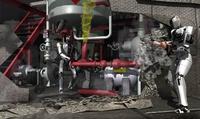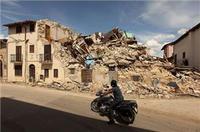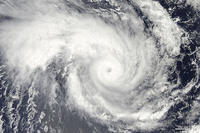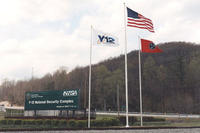-
Paintballs may deflect an incoming asteroid
With twenty years’ notice, paint pellets could cause an asteroid to veer off course; researchers say that, if timed just right, pellets full of paint powder, launched in two rounds from a spacecraft at relatively close distance, would cover the front and back of an asteroid, more than doubling its reflectivity, or albedo; the initial force from the pellets would bump an asteroid off course; over time, the sun’s photons would deflect the asteroid even more
-
-
FEMA will pay to replace University of Iowa buildings damaged in flood
The University of Iowa will receive nearly $84 million to replace an auditorium, as well as arts and music facilities, which were damaged by a flood; the decision comes after the Office of Inspector General (OIG) of DHS said that FEMA had improperly applied a rule requiring facilities to be repaired unless the damage exceeds 50 percent of the cost of building a replacement
-
-
Understanding the effects of Fukushima by studying fish
Japan’s “triple disaster,” as it has become known, began on 11 March 2011, and remains unprecedented in its scope and complexity; to understand the lingering effects and potential public health implications of that chain of events, scientists are turning to a diverse and widespread sentinel in the world’s ocean: fish; the data from Japan fisheries provide a look at how the ocean is faring eighteen months after the worst accidental release of radiation to the ocean in history
-
-
The DARPA Robotics Challenge begins

The DARPA Robotics Challenge (DRC) began yesterday, and DARPA wants to know whether you will be part of it; DARPA introduces teams for Tracks A and B, opens registration for Tracks C and D, and launches simulation software for download; the goal of the competition is to help advance robotic technology to the point where it can have a tangible impact on humanitarian assistance and disaster relief
-
-
Entrepreneurial approach to Japan’s disaster recovery
The 9.0 magnitude earthquake hit off the east coast of Japan in March 2011 killed more than 12,000 people, sent tsunami waves six miles inland, and damaged or completely flattened more than a million buildings; combined with the tsunami and the nuclear meltdown at Fukushima, it was the most economically damaging disaster in world history, costing Japan an estimated $235 billion, according to the World Bank; a Japanese organizations tries a new approach to disaster recovery: entrepreneurship
-
-
Italian seismologists sent to jail for failing to predict earthquake

A judge sentenced six Italian seismologists and a former government official to six years in prison over the deadly 6 April 2009 earthquake in L’Aquila; the seven defendants were found guilty of manslaughter for not alerting the public to the 6.3 magnitude; the tremor killed 309 people, injured thousands, and destroyed cities and villages in the affected region; scientists, alarmed by the verdict, have warned that the case might have a chilling effect, making scientists and experts think twice before sharing their knowledge with the public for fear of being targeted in lawsuits
-
-
Cosmic rays help gather information from inside the Fukushima nuclear reactors
Researchers have devised a method to use cosmic rays to gather detailed information from inside the damaged cores of the Fukushima Daiichi nuclear reactors which were heavily damaged in March 2011 by a tsunami that followed a great earthquake
-
-
A Mississippi river diversion helped build Louisiana wetlands
The extensive system of levees along the Mississippi River has done much to prevent devastating floods in riverside communities; the levees, however, have also contributed to the loss of Louisiana’s wetlands; by holding in floodwaters, they prevent sediment from flowing into the watershed and rebuilding marshes, which are compacting under their own weight and losing ground to sea-level rise
-
-
Corps: absolute flood protection along the Missouri River is impossible
A U.S. Army Corps of Engineers report said that absolute flood protection along the Missouri River is impossible, so the basin needs to prepare and plan for flooding in the future
-
-
Tropical cyclones are occurring more frequently than before

Are there more tropical cyclones now than in the past, or is it just something we believe because we now hear more about them through media coverage and are better able detect them with satellites? New research shows that there is an increasing tendency for cyclones when the climate is warmer, as it has been in recent years
-
-
Water level gauges failed during Hurricane Isaac
As Hurricane Isaac beat down on New Orleans, the damage it caused was nowhere near as severe as that of Katrina, but it lasted longer than most people expected and for the U.S. Army Corps of Engineers, it provided a field test of a multi-billion dollar investment in flood protection
-
-
Y-12 Nuclear Complex’s uranium processing facility to be redesigned

Weeks after the inadequacy of security measures at the Y-12 Nuclear Complex came to light — an 82-year old nun and her two senior citizen colleagues eluded the facility’s fences and security to spend a few hours on the site’s grounds and spray-paint anti-nuclear slogans on its walls – criticism is directed at the design shortcomings of a new uranium processing facility; among other things, the roof of the new facility will have to be raised by thirteen feet because the designers did not take into account the size of the equipment the new facility will house
-
-
Environmentalists concerned about earthquakes tests near California nuclear plant
The Pacific Gas and Electric Company (PG&E) wants to use air guns to emit strong sound waves into a large near-shore area which includes parts of marine reserves; the purpose: creating three dimensional maps of fault zones near its Diablo Canyon nuclear plant in California; the plans have federal and state officials concerned about marine life and public safety
-
-
New mobile app could save lives in earthquakes
A new iPhone app called has been developed to locate loved ones in the world’s earthquake zones during the event of an earthquake; the app, once downloaded, prompts users to enter their own details and those of four friends or family members in order to become their “Buddies”; in the event of an earthquake registering above 5.5, the user’s buddies will instantaneously receive an e-mail displaying a Google map of the user’s location
-
-
EU considers far-reaching Internet security initiative
Cybersecurity is becoming an increasingly more daunting challenge as governments try to prevent attacks against critical infrastructure on which the well-being of countries depends, now, several European countries are trying to come together in an effort to defend themselves against a cyber attack, but critics say the project, called CleanIT, goes too far
-
More headlines
The long view
The Surprising Reasons Floods and Other Disasters Are Deadlier at Night
It’s not just that it’s dark and people are asleep. Urban sprawl, confirmation bias, and other factors can play a role.
Why Flash Flood Warnings Will Continue to Go Unheeded
Experts say local education and community support are key to conveying risk.
